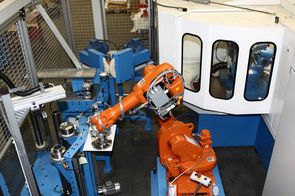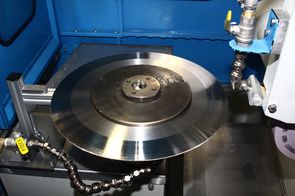Berger Blog
CNC grinding technology for mechanical blades
CNC grinding technology for mechanical blades


Forum Schneidwerkzeug- und Schleiftechnik, Juni 2019
Different grinding processes for tolerance-precise machining of circular knives, industrial blades, cutter knives, punching knives and other workpieces.
The term "machine blade" refers to a large number of workpieces of various geometries and sizes. Due to the large number of workpiece shapes and the complexity of some geometries, different grinding processes are used.
Surface grinding of machine blades
Surface grinding is a widely used grinding process. It is mainly used for machining plane and flat workpieces. Surface grinding can be achieved both in deep grinding and pendulum grinding.
Face side grinding machines process workpieces in face side cross grinding or face side deep grinding. With a cutting speed of up to 50 m/s, multi-sided smooth grinding of machine knives is achieved. Depending on the diameter of the cup grinding wheel used, workpieces with a grinding length of up to 1,200 mm can be machined.
CNC-controlled grinding machines are equipped with two feed axes and up to four contour-giving axes for the production of machine knives. Thanks to a combination of a stone axis to compensate for stone wear and an additional infeed axis to grind the workpiece, a high degree of rigidity is achieved. With an additional vertical axis and a rotation axis, a chamfer grinding on the contour of the workpiece is achieved in addition to the face grinding of the lateral surfaces.
If the workpiece is machined using the deep grinding process, large material rates are removed and good surface quality can be achieved.
Peripheral grinding wheels are used to achieve serrated grinding, scalloped grinding and/or pointed serrating on machine knives.
Specially designed peripheral grinding machines process long knives with a maximum length of 1,800 mm using up to six CNC axes. The peripheral grinding wheel is moved by four CNC axes and the angle of the magnetic clamping table is adjusted by two further CNC axes. The grinding machine serrates machine knives with a cutting speed of up to 65 m/s in orthogonal deep grinding or plunge grinding method.
Knives with straight or serrated cutting edges are ground at a programmable angle. The tooth forms are programmed in a user-friendly way via the menu. This makes it possible to quickly grind on almost any tooth profile, especially pointed or wavy gears, even for small quantities or prototypes. With the help of an additional CNC rotation axis, circular knives can be toothed with and without relief grinding.
Sensors in grinding technology
A central control unit connected to the grinding machine interacts both with an automated feeding system and with the workpiece and tool magazines.
A bus-based acquisition of sensor signals is integrated into the grinding machine. Via intelligent sensors and actuators, signals such as coolant temperatures, motor load, AE signals for spindle monitoring or air pressure are recorded and processed so that decisions can be made and implemented for resource control.
These process data are recorded via a specially developed interface in order to optimise production processes and recognise process dependencies. In this way, downtimes and setup times are optimized and capacity planning is improved.
Peripheral grinding of circular knives, saw blades, circular blanks and stem blades
Depending on the kind of grinding which has to be achieved, either peripheral or rotary table grinding machines are used to process circular knives, saw blades or circular blanks. With a cup wheel rotary table grinding machines achieve a jet grinding of round and cutter knives at high machining rates.
Peripheral grinding machines with up to six CNC axes achieve peripheral grinding on surfaces, cutting edges and contours of circular knives, saw blades, circular blanks and trunk blades. Surface or bevel grinding is achieved on circular knives with a maximum diameter of 1,200 mm using the pendulum or plunge-cut method.
By using an additional grinding axis, it is possible to process subsequent grindings in one clamping. In combination with a tactile measuring system with additional damping of the probe, an interrupted grinding can also be achieved with high precision. The circular knives are positioned in a rotating, continuously adjustable workpiece holder and held by a mechanical clamping device or by a permanent magnet or electromagnet. Workpiece feeding as well as loading and unloading of the processing machine can be automated. The grinding machine is often combined with a robot-controlled feeding system. The workpiece is positioned in the grinding machine by robots and then placed in another magazine after machining.
The traverse paths are automatically compensated after each dressing cycle and adapted to the preset peripheral speed via a frequency converter integrated in the control system.
Serrated grinding on circular and cutter knives
A CNC-controlled serrated grinding machine has been developed for machining circular and cutter knives as well as for grinding panel seats on the base bodies of circular saws.
The peripheral grinding machine is designed for the serrating of circular knives with a diameter of 50-500 mm or 500-850 mm. The machine and tooth profile are programmed via a four-axis CNC control.
(Author: Dr. Andreas Groß, Berger Gruppe, Excerpts from the lecture "CNC grinding machines, feeding technology and robotics for the production of machine knives" at the Machine Knives Symposium on 19.03.2019)
